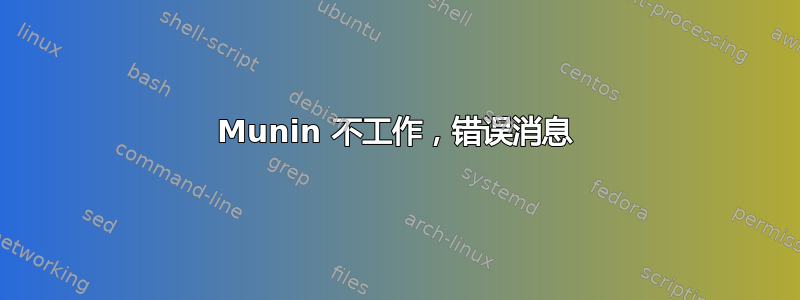
Munin 没有显示任何图表...当我进行 munin-update 时出现此错误:
/usr/share/munin/munin-update
2014/02/15 10:53:43 [ERROR] config error under [amavis] for 'group adm' : Parse error in /etc/munin/munin.conf for group:
Unknown keyword at end of left hand side of line 17 (group )
at /usr/share/munin/munin-update line 63
ERROR: Failed to parse config file '/etc/munin/munin-conf.d/munin-node': [ERROR] config error under [amavis] for 'group adm' : Parse error in /etc/munin/munin.conf for group:
Unknown keyword at end of left hand side of line 17 (group )
at /usr/share/munin/munin-update line 63
at /usr/share/munin/munin-update line 63
我的 munin.conf:
# Example configuration file for Munin, generated by 'make build'
# The next three variables specifies where the location of the RRD
# databases, the HTML output, logs and the lock/pid files. They all
# must be writable by the user running munin-cron. They are all
# defaulted to the values you see here.
#
#dbdir /var/lib/munin
#htmldir /var/cache/munin/www
#logdir /var/log/munin
#rundir /var/run/munin
# Where to look for the HTML templates
#
#tmpldir /etc/munin/templates
# Where to look for the static www files
#
#staticdir /etc/munin/static
# temporary cgi files are here. note that it has to be writable by
# the cgi user (usually nobody or httpd).
#
# cgitmpdir /var/lib/munin/cgi-tmp
# (Exactly one) directory to include all files from.
includedir /etc/munin/munin-conf.d
# You can choose the time reference for "DERIVE" like graphs, and show
# "per minute", "per hour" values instead of the default "per second"
#
#graph_period second
# Graphics files are generated either via cron or by a CGI process.
# See http://munin-monitoring.org/wiki/CgiHowto2 for more
# documentation.
# Since 2.0, munin-graph has been rewritten to use the cgi code.
# It is single threaded *by design* now.
#
#graph_strategy cron
# munin-cgi-graph is invoked by the web server up to very many times at the
# same time. This is not optimal since it results in high CPU and memory
# consumption to the degree that the system can thrash. Again the default is
# 6. Most likely the optimal number for max_cgi_graph_jobs is the same as
# max_graph_jobs.
#
#munin_cgi_graph_jobs 6
# If the automatic CGI url is wrong for your system override it here:
#
#cgiurl_graph /munin-cgi/munin-cgi-graph
# max_size_x and max_size_y are the max size of images in pixel.
# Default is 4000. Do not make it too large otherwise RRD might use all
# RAM to generate the images.
#
#max_size_x 4000
#max_size_y 4000
# HTML files are normally generated by munin-html, no matter if the
# files are used or not. You can change this to on-demand generation
# by following the instructions in http://munin-monitoring.org/wiki/CgiHowto2
#
# Notes:
# - moving to CGI for HTML means you cannot have graph generated by cron.
# - cgi html has some bugs, mostly you still have to launch munin-html by hand
#
#html_strategy cron
# munin-update runs in parallel.
#
# The default max number of processes is 16, and is probably ok for you.
#
# If set too high, it might hit some process/ram/filedesc limits.
# If set too low, munin-update might take more than 5 min.
#
# If you want munin-update to not be parallel set it to 0.
#
#max_processes 16
# RRD updates are per default, performed directly on the rrd files.
# To reduce IO and enable the use of the rrdcached, uncomment it and set it to
# the location of the socket that rrdcached uses.
#
#rrdcached_socket /var/run/rrdcached.sock
# Drop [email protected] and [email protected] an email everytime
# something changes (OK -> WARNING, CRITICAL -> OK, etc)
#contact.someuser.command mail -s "Munin notification" [email protected]
#contact.anotheruser.command mail -s "Munin notification" [email protected]
#
# For those with Nagios, the following might come in handy. In addition,
# the services must be defined in the Nagios server as well.
#contact.nagios.command /usr/bin/send_nsca nagios.host.comm -c /etc/nsca.conf
# a simple host tree
[localhost.localdomain]
address 127.0.0.1
use_node_name yes
#
# A more complex example of a host tree
#
## First our "normal" host.
# [fii.foo.com]
# address foo
#
## Then our other host...
# [fay.foo.com]
# address fay
#
## Then we want totals...
# [foo.com;Totals] #Force it into the "foo.com"-domain...
# update no # Turn off data-fetching for this "host".
#
# # The graph "load1". We want to see the loads of both machines...
# # "fii=fii.foo.com:load.load" means "label=machine:graph.field"
# load1.graph_title Loads side by side
# load1.graph_order fii=fii.foo.com:load.load fay=fay.foo.com:load.load
#
# # The graph "load2". Now we want them stacked on top of each other.
# load2.graph_title Loads on top of each other
# load2.dummy_field.stack fii=fii.foo.com:load.load fay=fay.foo.com:load.load
# load2.dummy_field.draw AREA # We want area instead the default LINE2.
# load2.dummy_field.label dummy # This is needed. Silly, really.
#
# # The graph "load3". Now we want them summarised into one field
# load3.graph_title Loads summarised
# load3.combined_loads.sum fii.foo.com:load.load fay.foo.com:load.load
# load3.combined_loads.label Combined loads # Must be set, as this is
# # not a dummy field!
#
## ...and on a side note, I want them listen in another order (default is
## alphabetically)
#
# # Since [foo.com] would be interpreted as a host in the domain "com", we
# # specify that this is a domain by adding a semicolon.
# [foo.com;]
# node_order Totals fii.foo.com fay.foo.com
#
你知道问题出在哪里吗?谢谢


